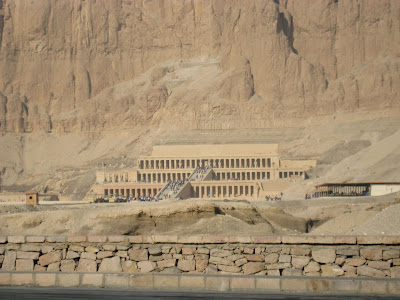Taking the tram into the Valley of the Kings
Today was filled with a visit to the Valley of the Kings, the Valley of the Queens, Queen Hatshepsut Temple, the Colossi of Memnon, and a trip to an alabaster factory, where vases are carved and polished by hand. We started early, leaving the ship at 7am, and took a ferry across the Nile to the West Bank. After a short car ride we were in the Valley of the Kings. Despite the early morning visit the sun had already begun to shine on the exposed valley. It truly is the land of the dead - no trees, no plants, no shade.
Entering the tomb of Ramses VI
We started our tour by entering the tomb of Ramses VI. The tomb entrance and passages are quite large, unlike the pyramid tombs. Throughout the tomb the walls and ceilings are full of paintings. It’s amazing that the paint is still visible after thousands of years. Apparently the paint was made from ground stone and oils into beautiful blues, reds, greens, yellows, black, and white. We finished our visit to the Valley of the Kings by visiting two more tombs, that of Ramses I and Ramses III, both full of more colorful paintings.
Next we headed to Hatshepsut Temple, an imposing structure built at the base of massive limestone hills. Hatshepsut is an interesting historical figure. Originally a queen of Egypt through marriage (and the half-sister of her husband, the pharaoh), she stole the throne from her young stepson after her husband died. She chose to rule Egypt as a man and is portrayed in statues and paintings with a false beard. After she died, her stepson took power and defaced most of her statues and images. Her mummy was recently discovered and identified by a missing tooth.
Hatshepsut Temple
The Valley of the Queens, where the tombs were built on a much smaller scale, was a few miles away from Hatshepsut Temple. The grander tombs here actually belonged to the pharaohs’ sons who died before the age of 7 (after the age of 7 the sons were buried in the Valley of the Kings). These tombs were much more pleasant to visit, as they had fewer visitors. Here we saw the tombs of Prince Amunherkhepshep, Prince Khaemweset, and Queen Titi.
At the alabaster factory we were shown how alabaster vases were made with hand tools- chisels, grinders, files and sandstone rocks to polish the vases when they were finished. After our tour we had the pleasure of visiting the shop. One of my least favorite things about Egypt is purchasing goods. L. and I were shown around and asked the price range. We were told, put what you want on the table and we will work out a price. This nearly put us off purchasing anything at all. We did find two pieces that we quite liked and began the bargaining process. The price started at some 1800 EP ($327) and immediately went down to 1600EP ($290) because of a discount. We said there was no way we could pay that much. He asked how much we thought we could pay. L. and I asked for a moment and decided we could pay at most 275EP ($50) for one or 440EP ($80) for both. He countered with 825EP ($150). We asked for a moment to talk it over and decided no, 440EP was our max. He said I can do 495EP ($90) and we said okay. So we walked out with 2 alabaster vases and 3 scarabs (a gift for good luck).
Our final stop of the day was the Colossi of Memnon, where we saw some really old graffiti (Greek and Roman). The Colossi are two statues of Amenhotep III, which originally guarded the entrance to his tomb (no longer present). The statues themselves are huge- 60 feet tall- but are incredibly poor condition. After snapping a few photos we made our way back to the boat for lunch.
L. and I had good intentions of heading into Luxor after lunch to check out streets off of the beaten path, but I drifted into a two-hour nap. The ship is now making its way towards Esna, which we will visit in the morning, and then Edfu and the temple of Horus.





No comments:
Post a Comment